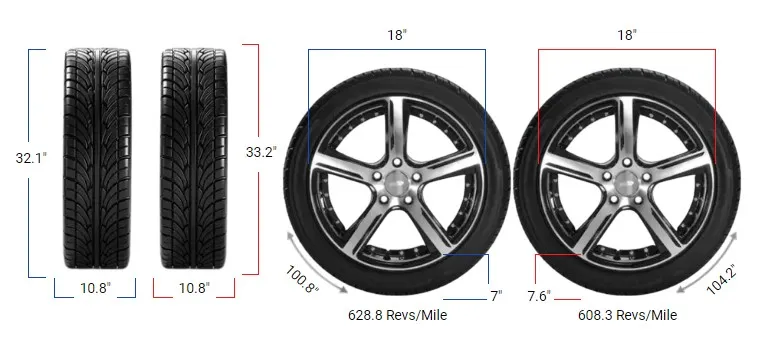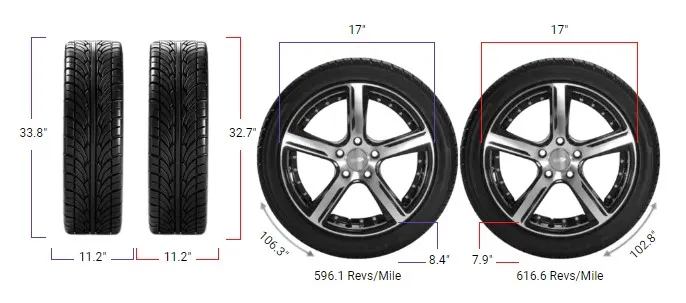Tire Size 255/75r15 vs 31×10.5r15
 If you’re considering a switch from 255/75R15 to 31×10.5R15 tires, it’s essential to know how these sizes affect your ride—both on-road and off-road.
If you’re considering a switch from 255/75R15 to 31×10.5R15 tires, it’s essential to know how these sizes affect your ride—both on-road and off-road.
- Larger overall diameter slightly improves ground clearance.
- Increased tire width provides better road grip and stability.
- Taller sidewalls improve ride comfort, especially on rough terrains.
- Wider tread enhances traction but may lead to more road noise.
- Lower revolutions per mile can affect speedometer readings.
- Bigger tires may slightly reduce fuel efficiency due to increased rolling resistance.
- More aggressive appearance adds a rugged aesthetic to the vehicle.

Fitment Guide
In this case, the 31×10.5R15 tire has a diameter difference of 3.1% compared to the 255/75R15, slightly exceeding the recommended range.
Such differences can create issues like rubbing or reduced clearance. If you’re still keen to make the switch, necessary adjustments should be made to prevent potential problems.
On-Road Impact
Switching tire sizes can have various on-road implications. Let’s dive into how the change impacts essential factors like gas mileage, ride comfort, speedometer accuracy, and more.
Gas Mileage
Switching to the 31×10.5R15 tires might affect your fuel efficiency. The larger diameter means fewer revolutions per mile, which can marginally lower the engine RPM on highways.
However, the increase in tire weight and rolling resistance may negate this effect, resulting in a slight decrease in gas mileage during everyday driving.

Ride Comfort
The sidewall height of the 31×10.5R15 tire is 7.99 inches compared to the 7.53 inches of the 255/75R15.
This additional sidewall height may enhance ride comfort by offering better shock absorption. However, this benefit might be countered by a slight increase in road noise, given the broader tread width.
Speedometer Accuracy
The larger diameter of the 31×10.5R15 tire means that your speedometer will read slightly lower than your actual speed.
For example, when your speedometer indicates 20 mph, your actual speed will be approximately 20.61 mph. While this discrepancy is relatively minor, it’s important to consider for maintaining accurate speed readings.
Aesthetics Look
Aesthetics also play a role in tire selection. The wider profile and slightly taller stance of the 31×10.5R15 tires provide a more aggressive look, which many off-road enthusiasts find appealing.
The increased width also gives the vehicle a more stable and rugged appearance, which is ideal for those looking to enhance the visual appeal of their truck or SUV.
Durability & Wear
Larger tires such as the 31×10.5R15 often have a higher load capacity, which can lead to increased durability under specific conditions.
However, the additional weight and larger contact patch could lead to faster tread wear, particularly if the vehicle is primarily used for on-road commuting rather than off-road adventures.
Off-Road Impact
The off-road capabilities of your vehicle can greatly improve by upgrading to larger tires. Let’s look at how switching to 31×10.5R15 tires affects vehicle capability, traction, and ground clearance.
Ground Clearance
The increased overall diameter of the 31×10.5R15 provides an additional 0.46 inches of ground clearance compared to the 255/75R15.
This additional clearance can make a significant difference when traversing rocky or uneven terrain, reducing the risk of undercarriage damage and enhancing off-road capability.
Traction
The wider footprint of the 31×10.5R15 tire also offers improved traction, especially in loose surfaces like sand, mud, or gravel. The increased contact area means better grip and stability when navigating off-road trails.
However, the broader tire may struggle more in deep snow compared to a narrower tire that can cut through the surface more effectively.
Vehicle Capability
Switching to the 31×10.5R15 tires can increase the off-road capability of your vehicle, allowing it to tackle more challenging terrain with ease.
The combination of improved ground clearance and traction means your vehicle is better equipped for off-road trails.
However, it’s important to remember that the increased tire size can put additional strain on the drivetrain and suspension components, especially if the vehicle isn’t lifted or otherwise modified.
255/75r15 vs 31×10.5r15
This table compares the key features of the 255/75R15 and 31×10.5R15 tire sizes.
| Feature | 255/75R15 | 31×10.5R15 | Difference |
|---|---|---|---|
| Diameter inches (mm) | 30.06 (763.5) | 30.98 (786.84) | 0.92 (23.34) +3.1% |
| Width inches (mm) | 10.04 (255) | 10.51 (267) | 0.47 (12) +4.7% |
| Circumference inches (mm) | 94.43 (2398.61) | 97.32 (2471.93) | 2.89 (73.32) +3.1% |
| Sidewall Height inches (mm) | 7.53 (191.25) | 7.99 (202.92) | 0.46 (11.67) +6.1% |
| Revolutions per mile (km) | 670.95 (416.91) | 651.05 (404.54) | -19.9 (-12.37) -3% |
| Speedo Reading | 20 mph | 20.41 mph | +0.41 mph |
Difference Between 255/75R15 and 31×10.5R15
The main difference is size: the 31×10.5R15 tire is 0.92 inches taller and 0.47 inches wider than the 255/75R15, affecting overall diameter and width.
Can I Use 31×10.5R15 Instead of 255/75R15?
No, it’s not recommended. The diameter difference is 3.1%, exceeding the advised limit of 3%. Using 31×10.5R15 may impact handling, speedometer accuracy, and safety.
How Much Taller Is a 31×10.5R15 Tire Than a 255/75R15?
The 31×10.5R15 tire is 0.92 inches (23.34 mm) taller than the 255/75R15, representing a 3.1% increase in diameter.
How Much Wider Is a 31×10.5R15 Tire Than a 255/75R15?
The 31×10.5R15 tire is 0.47 inches (12 mm) wider than the 255/75R15, which is a 4.7% increase in width.
Our Observation
Switching from 255/75R15 to 31×10.5R15 comes with both benefits and shortcomings. On-road, the increased diameter offers a slightly more comfortable ride due to a taller sidewall and enhanced shock absorption, but there could be a minor drop in fuel efficiency due to increased rolling resistance.
Speedometer readings will also be off by a small margin, which may be negligible for some but critical for others. Off-road, the benefits are more pronounced—the additional ground clearance and traction improve your vehicle’s capability on rugged terrain.
However, these advantages come with added strain on your suspension and potential issues with tire rubbing if the necessary adjustments are not made.
Ultimately, the impact of this change depends on your driving habits: if you prioritize off-road capability, the switch is beneficial; if you mostly drive on-road, the differences may be more of a compromise.



